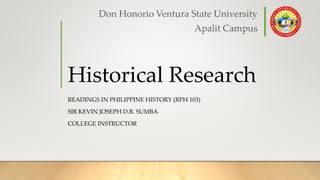
Lesson 3 - Historical Research.pptx
- 1. Historical Research READINGS IN PHILIPPINE HISTORY (RPH 103) SIR KEVIN JOSEPH D.R. SUMBA COLLEGE INSTRUCTOR Don Honorio Ventura State University Apalit Campus
- 2. INTENDED LEARNING OUTCOMES At the end of this lesson, students should be able to: • 1. To determine the contribution of different kinds of primary sources in understanding Philippine history. • 2. To analyze the content and context of different kinds of primary sources. • 3. To develop critical and analytical skills with exposure to primary sources.
- 3. HISTORICAL RESEARCH • Historical research is a qualitative technique. Historical research studies the meaning of past events in an attempt to interpret the facts and explain the cause of events, and their effect in the present events.
- 4. HISTORICAL RESEARCH • In doing so, researchers rely heavily on primary historical data (direct accounts of events, archival data - official documents, personal records, and records of eyewitnesses) and less frequently on secondary historical data (information from persons who didn’t witness the event; e.g. textbooks, newspapers, encyclopedias).
- 6. CONTEXTUAL ANALYSIS • A contextual analysis is simply an analysis of a text (in whatever medium, including multi-media) that helps us to assess that text within the context of its historical and cultural setting, but also in terms of its textuality – or the qualities that characterize the text as a text.
- 7. CONTEXTUAL ANALYSIS • A contextual analysis combines features of formal analysis with features of “cultural archeology, ” or the systematic study of social, political, economic, philosophical, religious, and aesthetic conditions that were (or can be assumed to have been) in place at the time and place when the text was created.
- 8. KEY QUESTIONS IN CONTEXTUAL ANALYSIS 1. What does the text reveal about itself as a text? • – Describe (or characterize) the language ( the words, or vocabulary) and the rhetoric (how the words are arranged in order to achieve some purpose). These are the primary components of style.
- 9. KEY QUESTIONS IN CONTEXTUAL ANALYSIS 2. What does the text tell us about its apparent intended audience(s)? • – What sort of reader does the author seem to have envisioned, as demonstrated by the text’s language and rhetoric? • – What sort of qualifications does the text appear to require of its intended reader(s)? How can we tell?
- 10. KEY QUESTIONS IN CONTEXTUAL ANALYSIS • – What sort of readers appear to be excluded from the text’s intended audiences? How can we tell? • – Is there, perhaps, more than one intended audience?
- 11. KEY QUESTIONS IN CONTEXTUAL ANALYSIS • 3. What seems to have been the author’s intention? Why did the author write this text? And why did the author write this text in this particular way, as opposed to other ways in which the text might have been written?
- 12. KEY QUESTIONS IN CONTEXTUAL ANALYSIS • – what the author said (the words that have been selected); • – what the author did not say (the words that were not selected); and • – how the author said it (as opposed to other ways it might or could have been said).
- 13. KEY QUESTIONS IN CONTEXTUAL ANALYSIS 4. What is the occasion for this text? That is, is it written in response to: • – some particular, specific contemporary incident or event? • – some more “general” observation by the author about human affairs and/or experiences? • – some definable set of cultural circumstances?
- 14. KEY QUESTIONS IN CONTEXTUAL ANALYSIS 5. Is the text intended as some sort of call to – or for – action? • – If so, by whom? And why? • – And also if so, what action(s) does the author want the reader(s) to take?
- 15. KEY QUESTIONS IN CONTEXTUAL ANALYSIS 6. Is the text intended rather as some sort of call to – or for – reflection or consideration rather than direct action? • – If so, what does the author seem to wish the reader to think about and to conclude or decide? • – Why does the author wish the readers to do this? What is to be gained, and by whom?
- 16. KEY QUESTIONS IN CONTEXTUAL ANALYSIS 7. Can we identify any non-textual circumstances that affected the creation and reception of the text? • – Such circumstances include historical or political events, economic factors, cultural practices, and intellectual or aesthetic issues, as well as the particular circumstances of the author's own life.
- 18. CONTENT ANALYSIS Content analysis is a qualitative research tool or technique that is used widely to analyze the content and its features. It is an approach used to quantify qualitative information by sorting data and comparing different pieces of information to summarize it into useful information.
- 19. CONTENT ANALYSIS • Holsti (1969) has defined content analysis as, “Any technique for making inferences by objectively and systematically identifying specified characteristics of messages.”
- 20. CONTENT ANALYSIS • The purpose of content analysis is to ‘read between the lines.’ It aims to determine answers to questions where the text implies something and is not necessarily explicit.
- 21. OBJECTIVES OF CONTENT ANALYSIS • To Identify the implied aspects of the content • To sketch the characteristics of the content • To analyze and present significant findings of content, clearly and effectively • To simplify unstructured content • To identify trends and relationships
- 22. OBJECTIVES OF CONTENT ANALYSIS • To spot the intentions of individuals or groups of people or an institution • To describe attitudinal and behavioral responses to communications • To determine the psychological or emotional state of a group of people • To justify an argument
- 23. Historical Research READINGS IN PHILIPPINE HISTORY (RPH 103) SIR KEVIN JOSEPH D.R. SUMBA COLLEGE INSTRUCTOR Don Honorio Ventura State University Apalit Campus
- 24. THANK YOU FOR LISTENING HISTORICAL RESEARCH